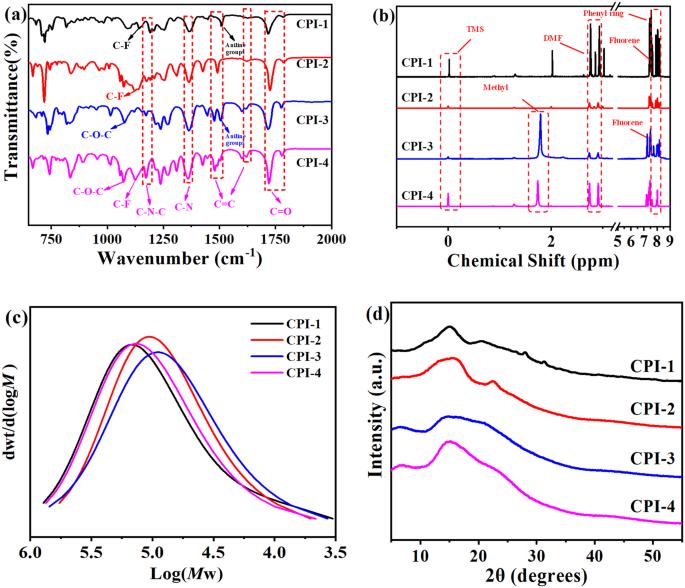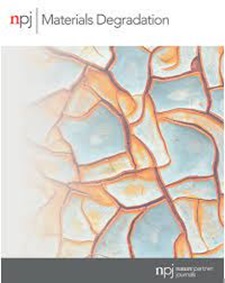合成用于光电应用的抗紫外线无色聚酰亚胺薄膜
IF 6.6
2区 材料科学
Q1 MATERIALS SCIENCE, MULTIDISCIPLINARY
引用次数: 0
摘要
聚酰亚胺(PIs)具有优异的机械性能和内在柔韧性,因此有望在恶劣条件下应用于光电领域,如柔性有机太阳能电池和柔性智能窗户等。聚酰亚胺在光学透射率方面取得了很大进展,但其环境稳定性,尤其是抗紫外线性能仍然令人担忧。本文精心设计了 4 种不同分子结构的无色聚酰亚胺(CPIs),分别含有三氟甲基、醚或芴,并系统地探讨了它们的抗紫外线性能与结构的关系。研究发现,由于共轭结构的微妙变化,引入异亚丙基、醚类和芴类物质可同时有效提高 CPI 的抗紫外线性能及其初始性能(光学透明度、热稳定性和韧性)。具体来说,优化后的聚酰亚胺薄膜具有良好的光学性能({T}_{550{\rm{nm}}$$ ~ 88%,黄度指数 ~3.26)和热稳定性({T}_{5 \% }$$ ~ 503 °C,氮气环境下,{T}_{\rm{g}}$$ ~ 312 °C)。此外,经过高强度紫外线照射后,CPI 不仅能保持 90% 以上的机械性能,还能保持优异的光学性能(${T}_{550{\rm{nm}}$$ ~ 88%)和热稳定性(${T}_{5 \% }$$ ~ 506 °C)。这种设计策略为提高聚合离子在能源转换和电子应用中抵御恶劣条件的耐久性铺平了道路。本文章由计算机程序翻译,如有差异,请以英文原文为准。

Synthesis of UV-resistant and colorless polyimide films for optoelectrical applications
Due to their excellent mechanical properties and intrinsic flexibility, polyimides (PIs) are promising candidates for optoelectrical applications under harsh conditions such as flexible organic solar cells as well as flexible smart windows, etc. Much progress has been made on their optical transmittance; however, there remain significant concerns about their environmental stability, particularly their UV resistance. Herein, 4 types of colorless polyimides (CPIs) with different molecular structures containing trifluoromethyl, ethers, or fluorenes are carefully designed, and the dependence of their UV resistance on structures is explored systematically. It is found that the introduction of isopropylidene, ethers and fluorenes effectively enhances the UV resistance of CPI and its initial performance (optical transparency, thermal stability, and toughness) simultaneously as a result of the subtle manipulation of the conjugation structures. Specifically, the optimized polyimide film shows decent optical properties ( $${T}_{550{\rm{nm}}}$$ ~ 88%, yellowness index ~3.26), and thermal stability ( $${T}_{5 \% }$$ ~ 503 °C in N2 atmosphere, $${T}_{{\rm{g}}}$$ ~ 312 °C). Moreover, after high-intensity UV irradiation, CPI not only maintains over 90% of mechanical properties but also retains excellent optical properties ( $${T}_{550{\rm{nm}}}$$ ~ 88%) and thermal stability ( $${T}_{5 \% }$$ ~ 506 °C). The design strategy paves the way for enhancing the durability of PIs for energy conversion and electronic applications resisting harsh conditions.
求助全文
通过发布文献求助,成功后即可免费获取论文全文。
去求助
来源期刊

npj Materials Degradation
MATERIALS SCIENCE, MULTIDISCIPLINARY-
CiteScore
7.80
自引率
7.80%
发文量
86
审稿时长
6 weeks
期刊介绍:
npj Materials Degradation considers basic and applied research that explores all aspects of the degradation of metallic and non-metallic materials. The journal broadly defines ‘materials degradation’ as a reduction in the ability of a material to perform its task in-service as a result of environmental exposure.
The journal covers a broad range of topics including but not limited to:
-Degradation of metals, glasses, minerals, polymers, ceramics, cements and composites in natural and engineered environments, as a result of various stimuli
-Computational and experimental studies of degradation mechanisms and kinetics
-Characterization of degradation by traditional and emerging techniques
-New approaches and technologies for enhancing resistance to degradation
-Inspection and monitoring techniques for materials in-service, such as sensing technologies
 求助内容:
求助内容: 应助结果提醒方式:
应助结果提醒方式:


